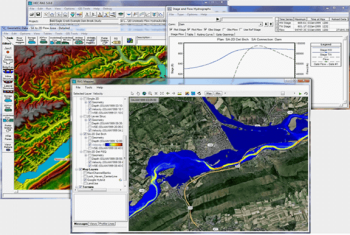Pre-Modeling Communication: Hydraulic Model Considerations: Difference between revisions
From ASDSO Dam Safety Toolbox
(Created page with "* State the software selection and describe the limitations of the program as they apply to this project. * Describe the hydraulic scenarios to be modeled and any scenario-specific assumptions that will be applied. * Note the sources of information and describe the uncertainties or limitations of that information. Also identify data needs and how those gaps will be addressed. * State whether a steady or unsteady flow condition will be modeled. Also state whether...") |
No edit summary |
||
| Line 1: | Line 1: | ||
<!-- Delete any sections that are not necessary to your topic. Add pictures/sections as needed --> | |||
{{Picture | |||
|image= | |||
<!-- Add image file name (ex.image.jpg) --> | |||
1dmodel-hecras.png | |||
|link= | |||
<!--https://www.hec.usace.army.mil/--> | |||
|caption= | |||
<!-- Add picture caption --> | |||
HEC-RAS is a program commonly used to generate one-dimensional hydraulic models. | |||
(Image Source: [https://www.hec.usace.army.mil/ Hydrologic Engineering Center, USACE]) | |||
}} | |||
* State the software selection and describe the limitations of the program as they apply to this project. | * State the software selection and describe the limitations of the program as they apply to this project. | ||
* Describe the hydraulic scenarios to be modeled and any scenario-specific assumptions that will be applied. | * Describe the hydraulic scenarios to be modeled and any scenario-specific assumptions that will be applied. | ||
| Line 5: | Line 19: | ||
* Describe the anticipated model extent and boundary conditions. Also note how model boundaries will be evaluated to assess calculation independence at the location(s) of interest in the model. | * Describe the anticipated model extent and boundary conditions. Also note how model boundaries will be evaluated to assess calculation independence at the location(s) of interest in the model. | ||
* Describe the source of flow data (including base flows, design flows, and hydrographs) and energy loss coefficients. | * Describe the source of flow data (including base flows, design flows, and hydrographs) and energy loss coefficients. | ||
* Describe the model geometry data including terrain data source and resolution as well as bridge, culvert, and other hydraulic structures within the wetted area of the model. | * Describe the model geometry data including [[Terrain Data|terrain data]] source and resolution as well as bridge, culvert, and other hydraulic structures within the wetted area of the model. | ||
* Summarize information regarding dams, [[spillways]], and [[reservoirs]] where reservoir routing will occur. This should include a description of reservoir routing methodology, initial reservoir levels, stage-storage-discharge curves, and assumed [[operation]] of gated spillways or outlet works. Information and assumptions regarding dam breach approach should also be provided if applicable. | * Summarize information regarding dams, [[spillways]], and [[reservoirs]] where [[Reservoir Routing|reservoir routing]] will occur. This should include a description of reservoir routing methodology, initial reservoir levels, stage-storage-discharge curves, and assumed [[operation]] of gated spillways or [[Outlet Works|outlet works]]. Information and assumptions regarding dam breach approach should also be provided if applicable. | ||
* If a parametric sensitivity analysis is planned, describe the approach. | * If a parametric sensitivity analysis is planned, describe the approach. | ||
* Describe the model validation or calibration approach. If historic gage data are used for calibration, provide detailed descriptions of the available information. | * Describe the model validation or calibration approach. If historic gage data are used for calibration, provide detailed descriptions of the available information. | ||
Revision as of 20:54, 21 June 2024

|
| HEC-RAS is a program commonly used to generate one-dimensional hydraulic models.
(Image Source: Hydrologic Engineering Center, USACE) |
- State the software selection and describe the limitations of the program as they apply to this project.
- Describe the hydraulic scenarios to be modeled and any scenario-specific assumptions that will be applied.
- Note the sources of information and describe the uncertainties or limitations of that information. Also identify data needs and how those gaps will be addressed.
- State whether a steady or unsteady flow condition will be modeled. Also state whether a one-dimensional, two-dimensional, or three-dimensional hydraulic model will be used. Justification should be provided for the selected approach based on project objectives and available data.
- Describe the anticipated model extent and boundary conditions. Also note how model boundaries will be evaluated to assess calculation independence at the location(s) of interest in the model.
- Describe the source of flow data (including base flows, design flows, and hydrographs) and energy loss coefficients.
- Describe the model geometry data including terrain data source and resolution as well as bridge, culvert, and other hydraulic structures within the wetted area of the model.
- Summarize information regarding dams, spillways, and reservoirs where reservoir routing will occur. This should include a description of reservoir routing methodology, initial reservoir levels, stage-storage-discharge curves, and assumed operation of gated spillways or outlet works. Information and assumptions regarding dam breach approach should also be provided if applicable.
- If a parametric sensitivity analysis is planned, describe the approach.
- Describe the model validation or calibration approach. If historic gage data are used for calibration, provide detailed descriptions of the available information.
